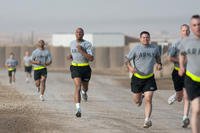When someone requires downtime or surgery after an injury, the recovery process typically involves a three-phased approach: protection from further injury, rehabilitation and rebuilding. All of these phases are designed by a physical therapist.
Here is a common question I get as a trainer and coach:
Hey Stew! I recently tore my MCL [medial collateral ligament in the knee] playing hockey; I have 6 weeks of recovery. Any exercises for me to do during recovery and after to stay in shape and help get it back to normal? Thanks, Liam
Quick answer: As a coach, I will not do anything with you or make recommendations until the physical therapist, doctor or surgical team has released you to full-duty status. Their expertise and guidance are crucial during this time. As you recover slowly, the physical therapist may allow certain activities, such as biking before running, calisthenics and stretching, before adding weight again. These are important pieces of information to adhere to, as they can be the difference between prolonged injury, reinjuring yourself or healing on schedule.
The post-injury rehab and rebuilding process typically involves more detailed and specific phases dependent on the injury, regardless of whether surgery is required. If surgery were performed, a more extensive but similar post-surgery rehab phase would also be necessary. A well-organized rehabilitation plan ensures a successful return to full activity. This plan typically consists of five phases, each with specific goals and exercises.
Reduce pain and swelling: The first phase focuses on controlling pain and reducing swelling. This may involve rest, ice, compression, elevation and gentle exercises to maintain mobility.
Start moving: In the second phase, the emphasis shifts to improving range of motion and flexibility. This may involve stretching, joint mobilization and gentle exercises to increase flexibility in the injured area. This may be painful initially, but it is important to start working on joint mobility and soft-tissue flexibility as soon as possible.
Rebuild strength and balance: In the third phase, the focus is improving strength and beginning balance training. This may involve resistance exercises, stability exercises and coordination drills to help regain strength and stability in the injured area.
Slowly back to training (a reintroduction): The fourth phase continues with movement, coordination of specific events and balance training. However, depending on the activity you are working to rebuild, you may be able to start introducing sport-specific exercises to prepare for a return to athletic activity. This may involve drills and movements that mimic the demands of the specific sport or activity.
Back to normal but with a gentle progression: Finally, the fifth phase emphasizes a gradual return to full activity. This may involve progressing from light to moderate to full-intensity exercises, gradually increasing the demands on the injured area.
It is imperative to adhere to the guidance provided by medical professionals and physical therapists to ensure a successful recovery and eventual return to full activity. Exercising patience and consistency throughout recovery is crucial to avoid setbacks and promote optimal healing.
Engage with the valuable expertise presented in the Military.com Fitness Section as you rebuild yourself. Take charge of your fitness training and recovery journey with great ideas to ensure a successful return to full activity.
Want to Learn More About Military Life?
Whether you're thinking of joining the military, looking for fitness and basic training tips, or keeping up with military life and benefits, Military.com has you covered. Subscribe to Military.com to have military news, updates and resources delivered directly to your inbox.




















